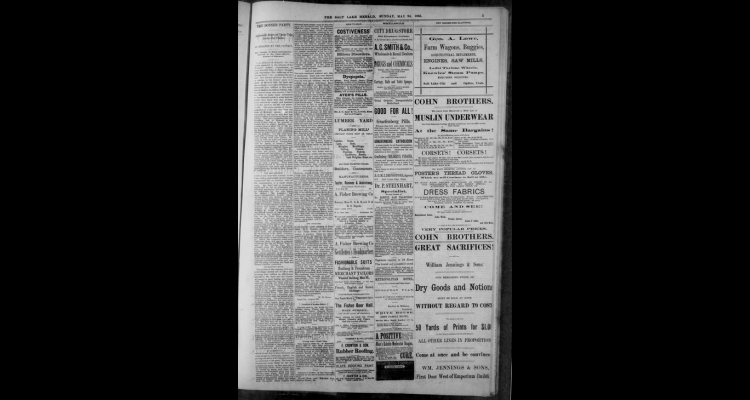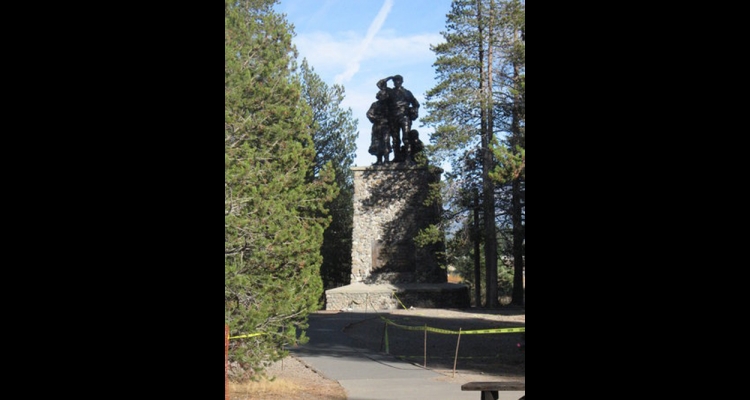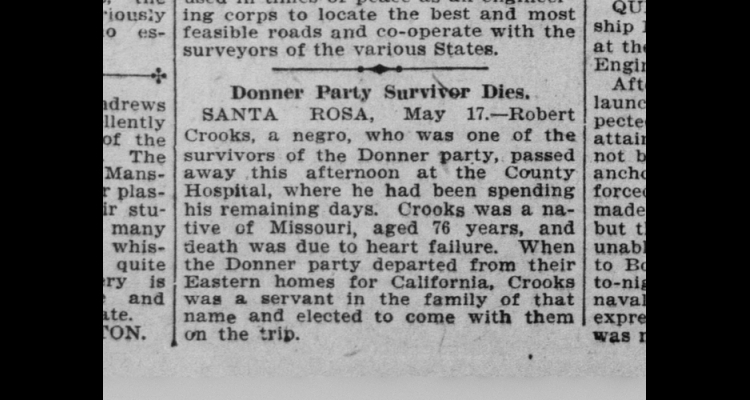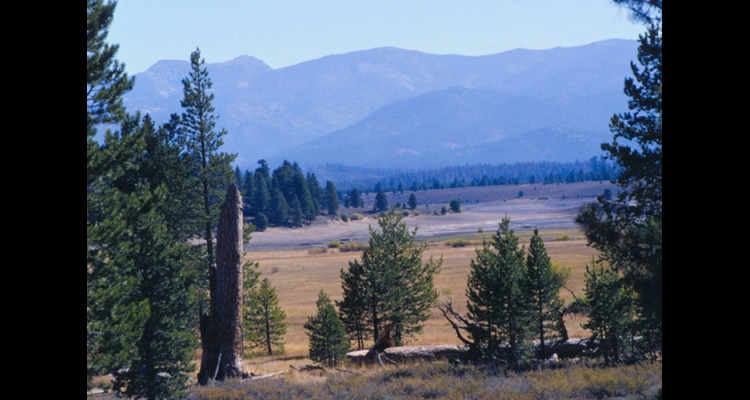Donner Party
Part 1: The Picnic
The Donner Party was a group of families that set off overland for California in ox-drawn covered wagons in 1846. They planned a two-thousand-mile, five-month walk across the continent to new opportunities, but were trapped in the Sierra Nevada Mountains by the terrible winter of 1846-47.
About half died, and some of the survivors resorted to cannibalism to stay alive. Their story has become a tragic icon of the American West.
The nucleus of the party was from Springfield, Illinois, and consisted of the families of George Donner; his brother, Jacob Donner; the James Frazier Reed family; and their hired hands. The three families and their employees, traveling in nine wagons, "jumped off into the wilderness," crossing the Missouri River at Independence, Missouri, on May 12, 1846.
At that time, thirty-three people were traveling together. They joined a larger wagon train captained by William H. Russell and traveled through Kansas, reaching the Platte River and the Oregon-California Trail in what is now Nebraska. James Reed's mother-in-law Margaret Keyes died of tuberculosis at the age of 70 in Alcove Springs, Kansas. She died in what has been called the "Pioneer Palace Car," a farm wagon Reed had modified for her comfort.
The members of the Donner Party sought land grants and a new start in California, which was then part of Mexico. The first segment of their journey along the Platte was comparatively uneventful. They traveled about eighteen to twenty miles per day and had plenty of provisions that were augmented by fresh elk and buffalo meat. There were few trees along the Platte, but the pioneers burned buffalo chips (dried bison dung) for fuel. Most of the emigrants walked; only the very young, very old, or very sick rode in the wagons.
The party reached Fort Laramie, a trading post in what is now Wyoming, on June 27. At the fort, James Reed told mountain man James Clyman that he was interested in a "shortcut" that would shave weeks and hundreds of miles off the trek to California. Rather than proceeding on the regular trail to Fort Hall, in what is now Idaho, the shortcut would take the emigrants through the rugged Wasatch Mountains, south of the Great Salt Lake, and then west across the Great Basin. Clyman warned Reed that the shortcut would be dangerous, but Reed wanted to hurry to California to secure the best land grants and spoke to the Donner brothers in favor of the plan. Clyman recalled Reed saying that, "There is a nigher (nearer) route, and it is of no use to take so much of a roundabout course."
The Donner and Reed families crossed the Continental Divide at South Pass on July 18. On the western slope of the Little Sandy River, in what is now Wyoming, they camped alongside several other overland parties. While there, the emigrants who had decided to take the alternate route, called the "Hastings Cutoff" after its promoter Lansford Hastings, formed a new wagon train. They elected George Donner as their captain, creating the Donner Party on July 19, 1846.
They made a left turn from the standard trail en route to Fort Bridger, a trading post operated by the famous trapper James Bridger and his partner, Louis Vasquez. Bridger, interested in encouraging a route that would bring travelers to his business, told them it would be an easy trip. Vasquez had a letter from Reed's friend Edwin Bryant warning Reed about the dangers of the cutoff but he failed to deliver the note.
The Donner Party rested at the trading post and set off on the "shortcut" on July 31, 1846.
Part 2: The Shortcut
In August 1846, the Donner Party, by then consisting of eighty-seven people in twenty-three wagons, was traveling on the Hastings Cutoff, a presumed shortcut on the California Trail.
Other families on the route included the Murphys, Breens, Graves, Eddys, and Kesebergs. The cutoff had been promoted by Lansford Warren Hastings, who was guiding wagons on the trail ahead of the Donner Party. One of those advance wagons had fallen off a precipice in Weber Canyon, so the Donner Party pioneered another route across the Wasatch Range in Utah.
The mountain wilderness slowed their progress and by August 22, the exhausted travelers broke through to the Salt Lake Valley. While crossing the eighty-mile-wide, waterless Salt Lake Desert, James Reed's oxen unexpectedly stampeded. They stayed a week at Pilot Springs, east of the present Wendover, Nevada, in a fruitless search for Reed's cattle. Already worried about provisions, they sent two men, Charles Stanton and William McCutchen, ahead on horseback to Sutter's Fort for supplies.
The demoralized party, by then comprised of groups of scattered families rather than a single unit, trekked around the Ruby Mountains and rejoined the standard California Trail at the Humboldt River on September 26. It was later calculated that the "shortcut" had added 125 miles to the trip. They had become the hindmost party in the California emigration of 1846; pioneers who had been behind them all along were now ahead of them on the trail.
The party was also harried by Paiute Indians, who wounded the Donner Party's cattle so that the animals would be left behind and could then be butchered. Furthermore, on October 5, near what is now Golconda, Nevada, James Reed killed John Snyder, a Graves family teamster, in a dispute when their wagons tangled while ascending a hill. After a standoff about whether to hang Reed, he was banished from the party. He traveled west on horseback with Walter Herron, one of his teamsters.
Two days later, Mr. Hardcoop, who had no wagon, was abandoned on the side of the trail. The Indian raids on the party's oxen continued, and Mr. Wolfinger stayed behind the others at the Humboldt Sink to bury his goods. It later was determined that he was killed by party members Joseph Reinhart and Augustus Spitzer.
The party crossed the 40-Mile Desert and reached the Truckee River around October 16. They reached the Truckee Meadows, site of present-day Reno, Nevada, around the last week of October and saw the Sierra already covered with snow. William Pike was killed in a firearms accident in camp, and the party ascended the Sierra Nevada Mountains with the Breens and others going first followed by the Donner families that brought up the rear.
Charles Stanton, accompanied by two Miwok Indian vaqueros, Luis and Salvador, and with supplies in hand, traveled from Sutter's Fort to rejoin the party near what is now Verdi, Nevada. The vanguard of the party, including Stanton, reached what is now Donner Lake on the night of October 31, 1846.
Stanton and the Indians scouted the pass and wanted to cross it, but the families at the lake decided to rest until morning. That night another storm reached the Sierras and snow fell at the lake as the Breens, Graves, Murphys, and others camped around a bonfire.
From November 1 until around November 20, the advance section of the Donner Party tried to cross the pass with wagons as well as without wagons, and they attempted to use oxen as pack animals. They were forced by deep snow and continuing storms to retreat to the lake.
The Donner families had camped about six miles from the lake after being delayed by a broken axle. George Donner cut his hand while repairing the wagon, an injury that would lead to infection and his death months later. The Donner families and those with them camped at Alder Creek near present-day Donner Lake in tents and makeshift shelters made of pine logs, brush, and canvas.
The Breen family took shelter at the lake in a cabin—at the site of what is now the Donner Memorial—built by members of the Townsend-Stephens-Murphy Party in 1844. The Murphys, Fosters, and Pikes built a shanty using a boulder for one wall. The Kesebergs stayed in a lean-to next to the Murphy cabin. The Graves group, including Mrs. Reed and her children, built a shelter at a site now traversed by Interstate 80.
On November 20, 1846, Patrick Breen began a diary. He wrote thus: "Came to this place on the 31st of last month that it snowed. We went on to the pass, the snow so deep we were unable to find the road, when within 3 miles of the summit, then turned back to this shanty on the Lake. . . . We now have killed most part of our cattle, having to stay here until next spring & live on poor beef without bread or salt. It snowed during the space of eight days with little intermission, after our arrival here."
Part 3: The Calamity
Through November and into December, storms gathered in the Gulf of Alaska, moved south, and were swept by the jet stream across what is now Donner Pass. The families huddled in their cabins and shelters hoping for a break in the weather.
On November 29, Breen wrote the following: "Still snowing. Now about 3 feet deep. Wind W[est]. Killed my last oxen today. Will skin them tomorrow. Gave another yoke to Fosters. Hard to get wood." By December 6, party members began making snowshoes out of split oxbows and rawhide for another escape attempt to be led by Stanton and the two Indians. By December 13, the snow was eight feet deep by Breen's estimate, with drifts much higher. Two days later, Baylis Williams, one of the former employees of the banished Reed family, became the first to die at the lake.
On December 16, the group that later came to be known as the Forlorn Hope Party set off on snowshoes from present-day Donner Pass. Two of the seventeen returned to camp, the other fifteen—ten men and five women—continued across the pass carrying scant rations. By December 21, the escape party reached Yuba Lake and was out of food. Stanton, their guide, had gone snow blind. He sat on a log, smoked his pipe, and told the others to go ahead. Rescuers later found his bones. Back at the high camps, Jacob Donner as well as three others from Alder Creek had died.
By Christmas Eve it was raining at the high camps. To the west, hungry and exhausted Forlorn Hope Party members were debating killing one of their own for food while resting at what would later be called the "Camp of Death." Franklin Graves and Antonio, a teamster, died there. The dying Graves told his daughters, Mary and Sarah, to use his flesh for food. On December 26, they did so, "averting their faces from one another and weeping."
During the last week of the year, Charles Burger died in the Keseberg family's lean-to and the lost escape party made its way west through the Sierras, enduring more casualties, including Jay Fosdick. On January 9, escape party member William Foster murdered Luis and Salvador and cannibalized their remains. Three days later the seven survivors—William Eddy, William Foster, and all five women—reached a Miwok village. On the night of January 17, Eddy, with the help of the Indians, arrived at the pioneer settlement at Johnson's Ranch. After wandering for a month, the seven survivors of the Forlorn Hope Party were safe.
California was embroiled in the Mexican-American War, but by early February the ten men of the First Relief (the initial rescue party), including brothers Daniel and John Rhodes, set out for the high camps. Back in the mountains, the entrapped pioneers boiled hides for sustenance, and the deaths continued. On February 19, seven men of the First Relief reached the lake.
"We raised a loud hello," Rhodes wrote, "then we saw a woman emerge from a hole in the snow. As we approached her, several others made their appearance…. They were gaunt with famine; and I never can forget the horrible, ghastly sight they presented. The first woman spoke in a hollow voice, very much agitated, and said, ‘Are you men from California or do you come from heaven?'"
The First Relief took twenty-three people from the camps and left the others, including the Breens, behind. On February 26, Breen wrote the following: "Mrs Murphy said here yesterday that [she] thought she would Commence on Milt. [Elliot's body] & eat him. I don't [believe] that she has done so yet; it is distressing. The Donners, 4 days ago, told the California folks that they [would] commence to eat the dead people… I suppose they have done so ere this time."
By March 1, the ten men of the Second Relief, including James Reed, arrived. They left with seventeen survivors, including the Breen family. Another great storm caught the escapees, who weathered it at what would become known as "Starved Camp." More people died, and the Breens were left behind as Reed and his companions took three children down the mountain. The Third Relief, led by Eddy and Foster, found the eleven survivors of Starved Camp, and John Stark took them out of the Sierras. The Third Relief reached the high camps on March 13 and found only nine people alive.
Tamsen Donner refused to abandon her dying husband, and the rescuers departed with four people, leaving five at the camps. The members of the Fourth Relief reached the lake in April and found only Lewis Keseberg alive, surrounded by the half-eaten remains of his companions. On April 29, Keseberg and his rescuers reached Sutter's Fort.
Of the eighty-one people who were entrapped at the high camps, thirty-six died and forty-five survived.
Of the eighty-seven pioneers who took the shortcut, thirty-nine died and forty-eight survived. Five were dead before the wagons ascended the Sierra Nevada, fourteen died at the lake camp, eight died at Alder Creek, and twelve died during the escape attempts. All of the Breens and Reeds survived; the other families were decimated.
Virginia Reed, 13, who wrote a letter to her cousin from her new home in California, gave the following advice to future pioneers: "Never take no cutoffs, and hurry along as fast as you can."
Article Locations
Related Articles
None at this time.





